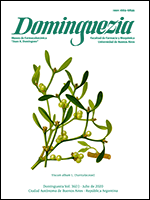Polyphenolic profile variation in Ligaria cuneifolia (R. et P.) Tiegh (Loranthaceae), capillary electrophoretic analysis and its relationship with the pharmacological activity
Abstract
Ligaria cuneifolia (R. et P.) Tiegh. €”Loranthaceae— is a hemiparasite plant which grows on different host trees. It is popularly referred to as "liga" or "liguilla". Due to its morphological similarity, it is considered as the natural substitute for the European mistletoe, for which is known as the "Argentine mistletoe". Herbal drugs are complex matrices in which multiple components acting synergistically are responsible for the pharmacological activity. In order to provide scientific support to the popular use of L. cuneifolia, a capillary electrophoretic method was developed and validated to build a chromatographic profile or fingerprint that allows the evaluation of different components for extract standardization. A comparison was made with other chromatographic techniques such as TLC and HPLC. Isolation, purification and structural analysis of compounds were performed by chromatographic and spectroscopic methods. Ten analytes were identified, four of which are reported for the first time in L. cuneifolia. Capillary electrophoresis proved to be an appropriate tool for the quality control of herbal drugs, as well as an attractive alternative to traditional chromatographic techniques.



